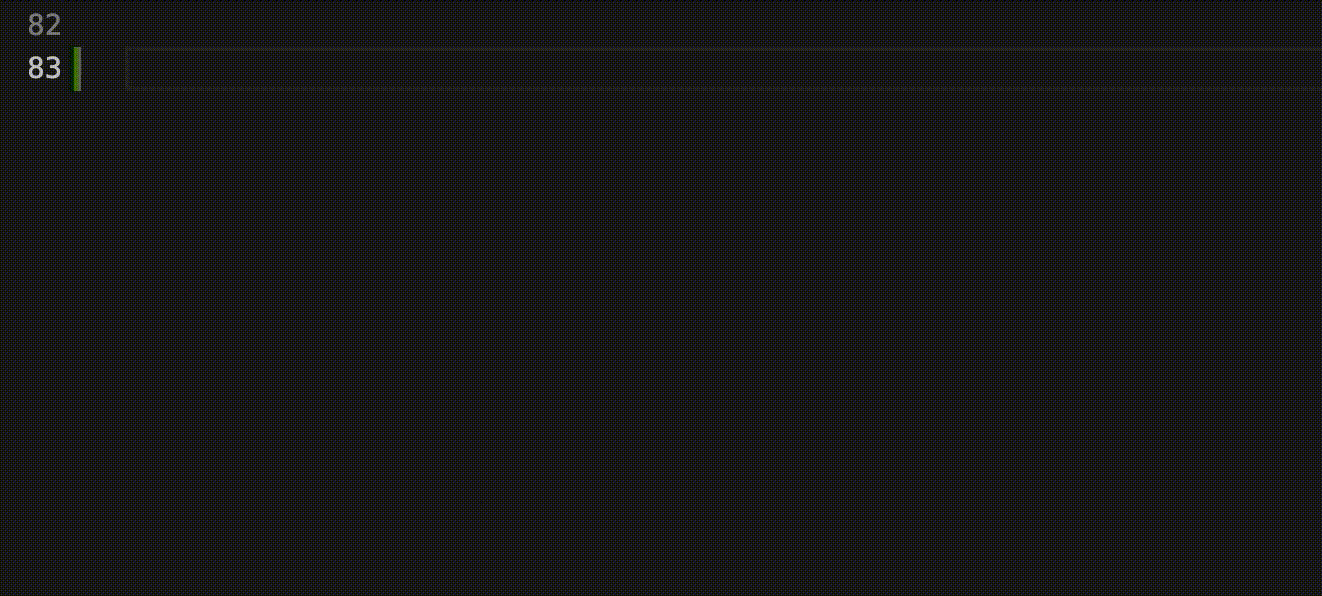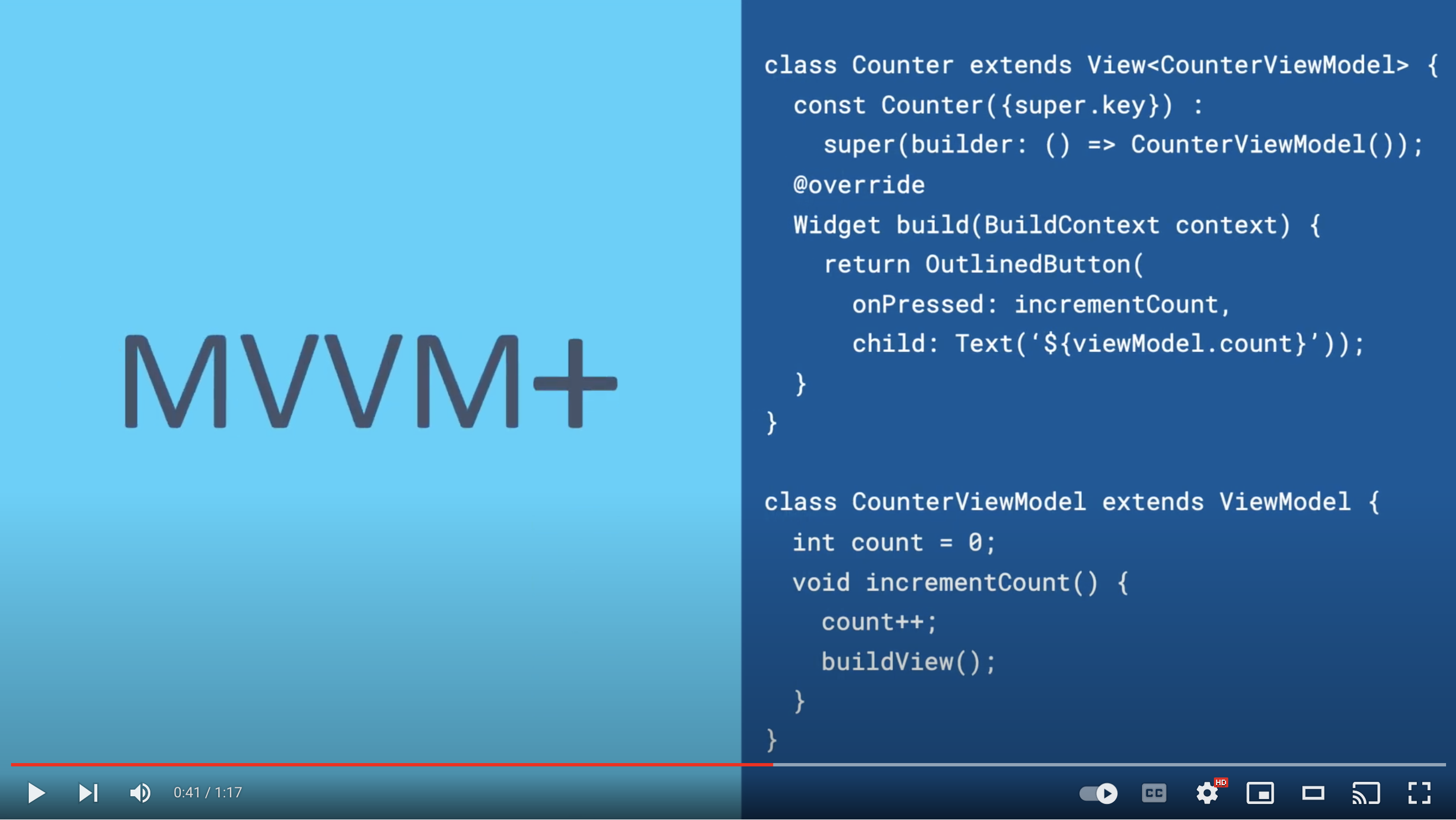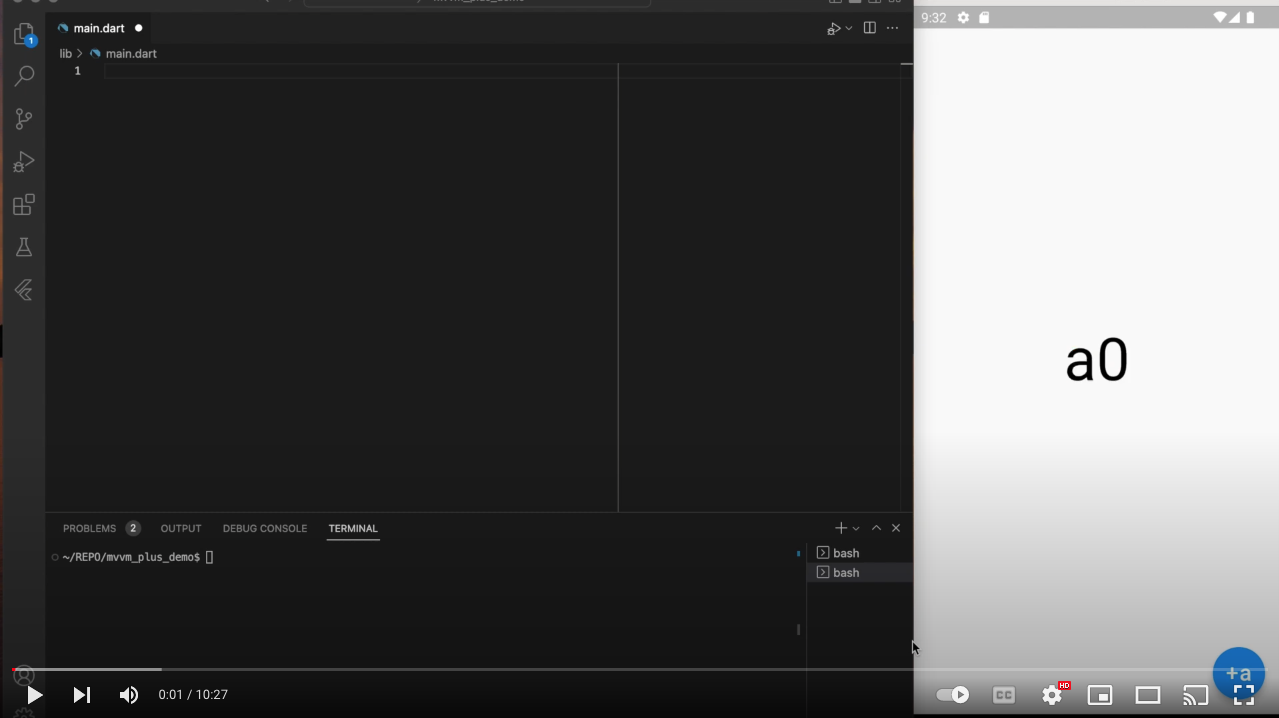mvvm_plus (mvvm+)

MVVM+ is a lightweight Flutter implementation of MVVM, plus a locator for sharing states via a global registry (like GetIt) or inherited widgets (like Provider).
YouTube videos
A one-minute introduction to MVVM+:
A longer demo video:
Tiny API
MVVM+ extends existing Flutter classes and introduces three methods: get, listenTo,
and buildView:
- Model extends ChangeNotifier and adds:
- get
- listenTo
- ViewWidget extends StatefulWidget/State and adds:
- get
- listenTo
- ViewModel extends Model and adds:
- buildView
- Property is a
typedefof ValueNotifier, so adds nothing.
But don't be fooled by MVVM+'s minimal interface. MVVM+ is a full implementation of MVVM.
Model-View-View Model (MVVM)
As with all MVVM implementations, MVVM+ organizes UI into an object called the View. Business logic associated with a View is organized into an object called a View Model. Business logic that spans two or more View Models is organized into one or more Models.

States are mutated in the View Model and the Model, but not the View. With MVVM+, the View is a Flutter widget and the View Model and Model are Dart models that extend ChangeNotifier.
MVVM+ goals:
- Clearly separate business logic and state from UI.
- Support access to models in a global registry (like GetIt).
- Support access to models from descendant widgets (like Provider, InheritedWidget).
- Work well alone or with other state management packages (BLoC, RxDart, Provider, GetIt, ...).
- Be scalable and performant, so suitable for both indy and production apps.
- Be simple.
- Be small.
Views and View Models
To create a View Model, extend ViewModel:
class MyWidgetViewModel extends ViewModel {
String someText;
}
To create a View, extend ViewWidget. You give the super constructor a builder for your ViewModel (via
the "builder" parameter) and you override ViewWidget's build function (just like
StatelessWidget):
class MyWidget extends ViewWidget<MyWidgetViewModel> {
MyWidget({super.key}) : super(builder: () => MyWidgetViewModel());
@override
Widget build(BuildContext context) {
return Text(viewModel.someText); // <- your "viewModel" getter
}
}
Views are frequently nested and can be large, like an app page or feature. Or small, like a password field or a button.
VSCode mvvm+ extension
The boilerplate for the ViewWidget and ViewModel classes is very similar to that of StatefulWidget and its State class. So, like the Flutter extension adds a "stful" snippet for writing StatefulWidget boilerplate, the mvvm plus extension adds a snippet for writing ViewWidget and ViewModel classes.

Search the VSCode extension marketplace for "mvvm plus". After installing the extension, just start typing "mvvm+" in the edit window and hit Enter when the mvvm+ snippet is highlighted. Then type the name of your widget and the extension will populate the naming for you. Hit tab to edit the build function.
Rebuilding a ViewWidget
ViewModel includes a buildView method for rebuilding the ViewWidget. You can call it explicitly:
class MyWidgetViewModel extends ViewModel {
int counter;
void incrementCounter() {
counter++;
buildView(); // <- queues ViewWidget to build
}
}
Or use buildView as a listener to bind the ViewModel to the ViewWidget with a ValueNotifier:
late final counter = ValueNotifier<int>(0)..addListener(buildView);
Because typing ..addListener(buildView) for every property can get tedious, ViewModel has a convenience method createProperty that adds the buildView listener for you. So you could refactor the line above as:
late final counter = createProperty<int>(0);
initState and dispose
Like the Flutter State class associated with StatefulWidget, the ViewModel class has initState
and dispose member functions which are handy for initialization and teardown.
class MyWidgetViewModel extends ViewModel {
late final streamCounter = createStreamProperty<int>(Stream.value(0));
@override
void dispose() {
streamCounter.dispose();
super.dispose();
}
}
Adding and getting ViewModels from the registry
Occasionally you need to access another widget's ViewModel instance (e.g., if it's an ancestor or on
another branch of the widget tree). To make a ViewModel globally available, use the ViewWidget specifier
location: Location.registry:
class MyOtherWidget extends ViewWidget<MyOtherWidgetViewModel> {
MyOtherWidget(super.key) : super(
location: Location.registry, // <- Adds the ViewModel to the registry
builder: () => MyOtherWidgetViewModel());
}
Views and ViewModels anywhere on the widget tree can access the ViewModel with their get or listenTo methods.
final otherViewModel = get<MyOtherWidgetViewModel>();
final otherViewModel = listenTo<MyOtherWidgetViewModel>();
Like GetIt, registered ViewModels are not managed by InheritedWidget. So, widgets don't need to be children of a ViewWidget to get its registered ViewModel. This is a big plus for use cases where the accessed ViewModel is not an ancestor.
Unlike GetIt the lifecycle of all ViewModel instances (including registered) are bound to the lifecycle of the ViewWidget instances that instantiated them. So, when a ViewWidget instance is removed from the widget tree, its ViewModel is disposed.
On rare occasions when you need to register multiple ViewModels of the same type, just give each ViewModel instance a unique name:
class MyOtherWidget extends ViewWidget<MyOtherWidgetViewModel> {
MyOtherWidget(super.key) : super(
location: Location.registry,
name: 'Header', // <- unique name
builder: () => MyOtherWidgetViewModel());
}
and then get the ViewModel by type and name:
final headerText = get<MyOtherWidgetViewModel>(name: 'Header').someText;
final footerText = get<MyOtherWidgetViewModel>(name: 'Footer').someText;
Alternatively, make ViewModels inherited (like Provider, InheritedWidget)
Instead of using the global registry, you have the option of adding ViewModels to the widget tree. Just add the specifier location: Location.tree, which makes the ViewModel available to descendants:
class MyOtherWidget extends ViewWidget<MyOtherWidgetViewModel> {
MyOtherWidget(super.key) : super(
location: Location.tree, // <- Puts ViewModel on the widget tree
builder: () => MyOtherWidgetViewModel());
}
Views and ViewModels that are descendants can use their context and get or listenTo functions to access the ViewModel.
final otherViewModel = get<MyOtherWidgetViewModel>(context: context);
final otherViewModel = listenTo<MyOtherWidgetViewModel>(context: context);
Models
The Model class is a super class of ViewModel with much of the functionality of ViewModel. MVVM+ uses the Bilocator package under the hood which has a widget named "Bilocator" that adds Models to the widget tree:
Bilocator<MyModel>(
builder: () => MyModel(),
child: MyWidget(),
);
By default, the Bilocator widget adds its model to the global registry when added to the widget tree and unregisters it when removed. (To register multiple models with a single widget, check out Bilocators).
As with the ViewWidget class, to add a model to the widget tree (instead of the registry), simply specify the location to Location.tree:
Bilocator<MyModel>(
builder: () => MyModel(),
location: Location.tree, // <- Adds model to widget tree instead of global registry
child: MyWidget(),
);
Listening to other widget's ViewModels
The get method of ViewWidget and ViewModel retrieves registered ViewModels but does not listen for
future changes. For that, use listenTo from within your ViewModel:
final someText = listenTo<MyOtherWidgetViewModel>().someText;
listenTo performs a one-time add of the buildView method as a listener that is called every time
the notifyListeners method of MyOtherWidgetViewModel is called. If you want to do more than just
queue a build, you can give listenTo a custom listener function:
final someText = listenTo<MyWidgetViewModel>(listener: myListener).someText;
If you want to rebuild your ViewWidget after your custom listener finishes, just call buildView within
your listener:
void myListener() {
// do some stuff
buildView();
}
Either way, listeners added by listenTo are automatically removed when your ViewModel instance is
disposed.
notifyListeners vs buildView
When your ViewWidget and ViewModel classes are instantiated, buildView is added as a listener to your
ViewModel. So, calling buildView or notifyListeners from within your ViewModel will both rebuild
your ViewWidget. So, what's the difference between calling buildView and notifyListeners? Nothing,
unless your ViewModel has other listeners. So, to eliminate unnecessary ViewWidget builds, it is a best
practice to use buildView unless your use case requires listeners to be notified of a change.
ValueNotifiers are your MVVM Properties!
The MVVM pattern uses the term "Properties" to describe public values of View Models that are bound to Views and other objects. I.e., when the Property is changed, listeners are notified:
class MyViewModel {
final counter = Property<int>(0);
}
In Flutter, this is how ValueNotifiers work. So, MVVM+ adds a typedef that equates Property with
ValueNotifier. As you use MVVM+, feel free to call your public members of ViewModels "Properties"
or "ValueNotifiers", whichever is more comfortable to you. (In the MVVM+ documentation, I use "
ValueNotifier" to be more transparent with the Flutter underpinnings, but in practice, I prefer to
use "Property" because it clarifies its purpose and because "Property" has fewer characters! :)
So, for more granularity than listening to an entire registered Model, you can get a model and listenTo one of its
ValueNotifiers/Properties:
final cloud = get<CloudService>();
final currentUser = listenTo<ValueNotifier<User>>(notifier: cloud.currentUser).value;
FutureProperty and StreamProperty
MVVM+ supports Flutter Future and Stream with the FutureProperty and StreamProperty. When
either of these resolves, its hasData field is set to true and its listeners are notified,
enabling rendering to update and access the values through its data field.
@override
Widget build(BuildContext context) {
return futureName.hasData
? Text('${futureName.data}')
: CircularProgressIndicator();
}
For Streams, use the subscription getter for pausing or canceling listening to the stream.
late final streamCounter = createStreamProperty<int>(Stream.value(0));
:
streamCounter.subscription.pause();
:
streamCounter.subscription.cancel();
Alternatively, the StreamProperty.dispose() cancels the subscription.
Mixins
The ViewWidget class is an extensions of a StatefulWidget, complete with the usual State class under the hood
(named ViewState) that manages View and its ViewModel. Some packages include a mixin that must be mixed in
with State. For this, you can extend ViewState to include your mixin. See the example below:
class MyWidget extends ViewWidget<MyWidgetViewModel> {
MyWidget({super.key}) : super(builder: () => MyWidgetViewModel());
@override
// Overriding createState is only required when adding mixins
MyWidgetState createState() => MyWidgetState();
@override
Widget build(BuildContext context) {
// Use `getState` to retrieve your custom ViewState/mixin object
return getState<MyWidgetState>().buildGreeting(viewModel.message.value);
}
}
// Extend `ViewState` and add your mixin
class MyWidgetState extends ViewState<MyWidgetViewModel> with MyMixin {}
mixin MyMixin {
buildGreeting(String message) => Text(message);
}
class MyWidgetViewModel extends ViewModel {
late final message = createProperty<String>('Hello');
}
Additional documentation
For an in-the-weeds discussion of the code behind MVVM+, see my medium article How to Extend StatefulWidget into an MVVM Workhorse .
For an slightly higher level introduction to MVVM+, see my article Flutter State Management with MVVM+ . Please note that most of this ReadMe page overlaps with this article.
To learn more about the bilocator package that MVVM+ uses for its locator, see the bilocator documentation.
If you are migrating from Provider, see How to Migrate Your Flutter App from Provider to MVVM+.
Example
The source code for the repo example is under the Pub.dev "Example" tab and in the
GitHub example/lib/main.dart file.
The example is a great way to familiarize yourself with MVVM+. It has several counters which demonstrate most of the classes in MVVM+.

That's it!
The example app demos much of the above functionality and shows how small and organized MVVM+ classes typically are.
If you have questions or suggestions on anything MVVM+, please do not hesitate to contact me.

